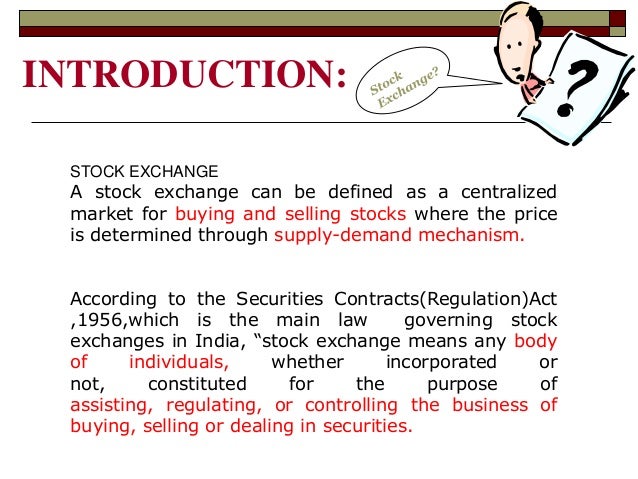Introduction of stock market indices
By gaining a clear understanding of how indices are created and how they differ, you will be on your way to making sense of the daily movements in the marketplace. Here we'll compare and contrast the main market indices so that the next time you hear someone refer to "the market," you'll have a better idea of just what they mean.
The Dow Jones Industrial Average DJIA is one of the oldest, most well-known and most frequently used indices in the world. It includes the stocks of 30 of the largest and most influential companies in the United States. The DJIA is what's known as a price-weighted index.
It was originally computed by adding up the per-share price of the stocks of each company in the index and dividing this sum by the number of companies—that's why it's called an average.

Unfortunately, it is no longer this simple to calculate. Over the years, stock splits, spin-offs, and other events have resulted in changes in the divisor , making it a very small number less than 0. The DJIA represents about a quarter of the value of the entire U. This is because of the Dow's price-weighted function. A change in the Dow represents changes in investors' expectations of the earnings and risks of the large companies included in the average.
Because the general attitude toward large-cap stocks often differs from the attitude toward small-cap stocks, international stocks or technology stocks, the Dow should not be used to represent sentiment in other areas of the marketplace.
On the other hand, because the Dow is made up of some of the most well-known companies in the U. Made up of of the most widely traded stocks in the U. The Wilshire is sometimes called the "total stock market index" or "total market index" because almost all publicly-traded companies with headquarters in the U.
Finalized in , this index is extremely diverse, including stocks from every industry. Although it's a very comprehensive measure of the entire U.
Most investors know that the Nasdaq is the exchange on which technology stocks are traded. The Nasdaq Composite Index is a market-capitalization-weighted index of all stocks traded on the Nasdaq stock exchange.
This index includes some companies that are not based in the U. Although this index is known for its large portion of technology stocks, the Nasdaq Composite also includes stocks from financial, industrial, insurance and transportation industries, among others.
Consequently, its movement generally indicates the performance of the technology industry as well as investors' attitudes toward more speculative stocks.
Global & Indian Stock Market Analysis: NSE/BSE Indices & Market Trends at IIFL
The Russell is a market-capitalization-weighted index of the 2, smallest stocks in the Russell , an index of the 3, largest publicly-traded companies, based on market cap, in the U. The Russell index gained popularity during the s when small-cap stocks soared, and investors moved more money to the sector. The Russell is the best-known indicator of the daily performance of small companies in the market; it is not dominated by a single industry.
NSE - National Stock Exchange of India Ltd.
It's good to know what's going on in the many diverse segments of the U. By watching indices and keeping track of their movements over time, you can get a good handle on the investing public's general attitude toward companies of all different sizes and from varying industries.

Dictionary Term Of The Day. A measure of what it costs an investment company to operate a mutual fund. Latest Videos PeerStreet Offers New Way to Bet on Housing New to Buying Bitcoin? This Mistake Could Cost You Guides Stock Basics Economics Basics Options Basics Exam Prep Series 7 Exam CFA Level 1 Series 65 Exam.

Sophisticated content for financial advisors around investment strategies, industry trends, and advisor education. An Introduction to Stock Market Indices By Kate Schick Updated April 27, — 3: The Dow The Dow Jones Industrial Average DJIA is one of the oldest, most well-known and most frequently used indices in the world.
The Wilshire The Wilshire is sometimes called the "total stock market index" or "total market index" because almost all publicly-traded companies with headquarters in the U. The Nasdaq Composite Index Most investors know that the Nasdaq is the exchange on which technology stocks are traded.
An Introduction To Stock Market Indexes
The Russell The Russell is a market-capitalization-weighted index of the 2, smallest stocks in the Russell , an index of the 3, largest publicly-traded companies, based on market cap, in the U. The Bottom Line It's good to know what's going on in the many diverse segments of the U.
Learn about the advantages and disadvantages of stock indexes and passive index funds. Discover how there is an opportunity cost to using index funds. Each index has its own approach to measuring stocks.
Although the DJIA only includes 30 stocks, it can tell you a lot about the market as a whole. Find out how the SPDR Dow Jones Industrial Average ETF compares with the iShares Russell Top as mega-cap exchange-traded funds.
Find out how the first market averages were calculated and what they mean for investors today. The Dow Jones Industrial Average DJIA is a price-weighted index that measures the daily price movements of 30 large American The Dow refers to the Dow Jones Industrial Average DJIA , an important index that indicates how well the overall stock market There is a variety of market indices which function as statistical gauges of the market's activities.
The best place to find a list of all thirty stocks included in the Dow Jones Industrial Average DJIA is the "Historical Learn how many components comprise the Dow Jones Industrial Average and understand the stock index's origins and how it is An expense ratio is determined through an annual A hybrid of debt and equity financing that is typically used to finance the expansion of existing companies.
A period of time in which all factors of production and costs are variable. In the long run, firms are able to adjust all A legal agreement created by the courts between two parties who did not have a previous obligation to each other.
The ABCs Of Stock Indexes
A macroeconomic theory to explain the cause-and-effect relationship between rising wages and rising prices, or inflation. A statistical technique used to measure and quantify the level of financial risk within a firm or investment portfolio over No thanks, I prefer not making money.
Content Library Articles Terms Videos Guides Slideshows FAQs Calculators Chart Advisor Stock Analysis Stock Simulator FXtrader Exam Prep Quizzer Net Worth Calculator. Work With Investopedia About Us Advertise With Us Write For Us Contact Us Careers.
Get Free Newsletters Newsletters. All Rights Reserved Terms Of Use Privacy Policy.